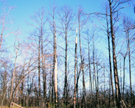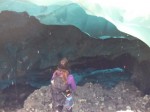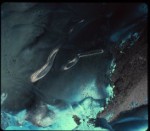A notorious, ridiculous and campy troupe that appears at fairs around the country each year. They seem to do little else but line up and slowly parade by gawking spectators, but maybe that’s all it really takes.
This handsome couple is doubly out of sync with both modern times, and the medieval/Renaissance revelers all around them. They were sitting at the bar, near a grounded Pirate Ship boutique, at the PA Renfest last year. If you thought you were viewing some Victorian Costumer movie outake starring Jane Seymour and Gene Wilder, you’re not alone!
Title Baby Vincent, 11 months
Location Van Nuys, California April 2013
Technical Fuji GA645w (slide bar, F22, 2”, Kodak EPR 64)
Comments He is my little star, my darling, my 4th child in 5 years, my second son, and my future. The only way to photograph a baby cha-cha style is while they sleep. Here he is shot with my Fuji GA645 closeup filter, with a Benbo tripod hanging over his body. His eyes fluttered when I pressed the release on the 2nd and 3rd exposures. I used the 1st and 4th exposures and got lucky because the separation of 1cm was made for pairs 1&2 or 3&4, but 1&4 also had 1cm and created the proper separation for this 3D image.
Title: Statue of Alfred Eisenstaedt’s V-J Day Life Magazine Photograph Aboard the USS Iowa Battleship
Location San Pedro, California December 2012
Technical Fuji GA645w (cha-cha no slide bar ), Fuji Provia F100
Comments In 2012 the West Coast’s only Battleship opened to the public in San Pedro with the USS Iowa. The self-guided tour takes you on a journey through World War II, the Korean War, and the Cold War to experience the life of a sailor on the lead ship of the last class of gunships. The USS Iowa was the only ship of her class to have served in the Atlantic Ocean during World War II. Despite the 16” guns, 5” guns, missile decks, bridge, mess areas, and world famous Captain’s Cabin – with the only bathtub installed on a battleship for a President, the most interesting item on the boat for me was this statue errected of the photograph of the nurse’s iconic kiss that marked the end of World War II. The battleship alone is certainly a symbol of this and world peace but for a public display, they chose to combine the weapon of a battleship with the softness of a kiss. The lasting power of a single photograph lives on.
On Aug. 14, 1945 New York City’s Times Square went dark at 7 p.m. and then at 7:03 p.m.,more than 750,000 people roared in jubilation as the words “OFFICIAL—TRUMAN ANNOUNCES JAPANESE SURRENDER” blazed across the news scroll. Elated by the news, people in the crowd were hugging and crying tears of joy, but it was a far different experience for Edith Shain, a nursing school student. “This sailor just grabbed me and kissed me,” she said. “Any female closes her eyes when she’s about to kiss so I never saw the guy, and then I walked away. I was kind of embarrassed. I didn’t say anything about it to anyone.” What Shain didn’t realize, until a week later, was that her “indiscretion” was caught on film. While browsing a copy of a Life magazine, Shain, then 27-years-old, recognized herself in what has became an iconic photo titled “V-J Day” (Victory over Japan) of a sailor slightly dipping a nurse in a white uniform and kissing her. Of the kiss, Shain said, “It was very nice, and of course, it was in the days before you’d scream and go to an attorney. It was the best of times.” The famous photo was taken by Alfred Eisenstaedt, a photojournalist for Life Magazine. In his memoirs, Eisenstaedt explained, “Suddenly, in a flash, I saw something white being grabbed. I turned around and clicked the moment the sailor kissed the nurse….People tell me that when I am in heaven they will remember this picture.” Though Eisenstaedt died in 1995 at the age of 96, the celebrated picture has not lost its significance. In celebration of the 60th anniversary of V-J Day, Shain flew to New York City where a slightly larger-than-life-size statue titled “Unconditional Soldier” by J. Seward Johnson based on the Life photograph was unveiled on Aug. 11, in Times Square.
Title View from the Shoin Building of The Japanese Garden
Location Van Nuys, California April 2013
Technical Fuji GA645w (cha-cha no slide bar ), Fuji Provia F100
Comments Major architectural entities in the garden include the Shoin building which projects over the lake and adjoins the teahouse. Shoin was the residential dwelling developed for aristocrats, upper class monks and samurai during the 14th and 15th centuries. The exterior of this building is authentically shoin style, but the interior has been modified to provide a place for meetings and special events. While the room does survey a panoramic view of the garden, notice the white window blinds that slide horizontally. The Japanese garden style is to reveal only portions of the garden at a time from a seating and not the entire panoramic view at once.
Location Van Nuys, California April 2013
Technical Fuji GA645w (cha-cha no slide bar ), Fuji Provia F100
Comments The Japanese Garden, dedicated June 18th, 1984, is a 6½ acre authentic Japanese garden fashioned after “stroll gardens” constructed during the 18th and 19th centuries for Japanese Feudal lords. The trees are manicured to reduce any dense foliage and promote three dimensional views that allows one to see the pines, lake, and administration building in the background. The foot path allows two people to enter together in order to encourage courtesy and to allow the viewing of small portions of The Garden from different vantage points.
This is my 3rd submission to the folio. It is an honor and privilege to share my slides and view the wonderful work of the other participants. It was fun to meet some of you at this year’s NSA and I look forward to meeting you again soon.
Koi: This was shot at the Mission San Juan Capsitrano during the NSA field trip. All are shot with TL120, This was Velvia 100 at f 16, 1/125
Alice and Mom: This is my wife and her mother Efke 25, sb28 flash at auto f8.
Flower arrangement: f22 1s velvia
Hummingbird and Quen Mary: This was shot during the NSA trip. I was lucky enough to catch this Hummingbird fly into the scene. I love the contrast in scale. Velvia f22 1/60
Palo Duro Canyon State Park opened on July 4, 1934 and contains 29,182 acres of the scenic, northern most portion of the Palo Duro Canyon. The Civilian Conservation Corps of the 1930’s constructed most of the buildings and roads still in use by park staff and visitors.
The Canyon is 120 miles long, as much as 20 miles wide, and has a maximum depth of more than 800 feet. Its elevation at the rim is 3,500 feet above sea level. It is often claimed that Palo Duro Canyon is the second largest canyon in the United States. The largest, the Grand Canyon, is 277 miles long, 18 miles wide, and 6,000 ft. deep.
Palo Duro is Spanish for “hard wood”. The photo was taken from the roof of our CCC constructed cabin located on the rim of the canyon. Only 3 cabins have a rim “view”. I am fascinated by the CCC work and visit and/or stay in CCC constructed cabins whenever we can.
I provided all the relevant data in the previous post on Bastrop State Park. 2011 Texas experienced a severe drought, over 300 million trees died. My photos do not begin to depict the severity of the wildfire in the park. The park will take decades to reco ver. The Lost Pines of Texas near Bastrop are important as they are the westernmost edge of the species’ natural range.
ver. The Lost Pines of Texas near Bastrop are important as they are the westernmost edge of the species’ natural range.
All photos were shot with the TL120 and I used either Provia or Kodak 100. And they were handheld using natural light. F/stop not recorded nor remembered.

 The fire ignited on the afternoon of September 4, 2011 near Bastrop, Texas with high winds that knocked drought-weary trees into power lines (Bastrop is about 30 miles southeast of Austin). The blaze created a 16-mile-long front line and galloped at 5 miles per hour, speeding through treetops and jumping state roads. It took 250 firefighters from around the country and 160 fire trucks and other equipment three days to contain the fire. The fire devoured 32,400 acres and destroyed nearly 1,700 homes. The endangered Houston toad was believed to have lost the vast majority of its habitat in the fire. The sign in this photo talks about the Houston toad habitat. The irony is that the sign, in the upper left hand corner, says “Enter with care”. This is in Bastrop State Park where the fire consumed 96% of the park which was home to the loblolly pines, known as the lost pines. The park is slowly recovering. My photo, taken in November 2012, shows where the underbrush has already made a quick comeback. I added a photo of the fire, not taken by me.
The fire ignited on the afternoon of September 4, 2011 near Bastrop, Texas with high winds that knocked drought-weary trees into power lines (Bastrop is about 30 miles southeast of Austin). The blaze created a 16-mile-long front line and galloped at 5 miles per hour, speeding through treetops and jumping state roads. It took 250 firefighters from around the country and 160 fire trucks and other equipment three days to contain the fire. The fire devoured 32,400 acres and destroyed nearly 1,700 homes. The endangered Houston toad was believed to have lost the vast majority of its habitat in the fire. The sign in this photo talks about the Houston toad habitat. The irony is that the sign, in the upper left hand corner, says “Enter with care”. This is in Bastrop State Park where the fire consumed 96% of the park which was home to the loblolly pines, known as the lost pines. The park is slowly recovering. My photo, taken in November 2012, shows where the underbrush has already made a quick comeback. I added a photo of the fire, not taken by me.
 Today, we’re going back to the ice but we’re not going to move much once we get there. All of the images here were made within 50-feet of each other. The subject is a fairly stable ice cave. I say fairly because it was created by an active creek so there is water flowing into it. The ground is mud, silt, ice, and gravel and is sliding into the cave and under the glacier. The ceiling is made of ice and is full of mud, silt, and gravel and is falling onto the floor. While I was working, some nice ladies stopped in to visit the cave. I used my Fuji to get a set-the-scene snapshot.
Today, we’re going back to the ice but we’re not going to move much once we get there. All of the images here were made within 50-feet of each other. The subject is a fairly stable ice cave. I say fairly because it was created by an active creek so there is water flowing into it. The ground is mud, silt, ice, and gravel and is sliding into the cave and under the glacier. The ceiling is made of ice and is full of mud, silt, and gravel and is falling onto the floor. While I was working, some nice ladies stopped in to visit the cave. I used my Fuji to get a set-the-scene snapshot.
Just inside the cave, the layers of the ice are obvious. The younger ice is above, the older ice is denser and is funneling the melt water out to the edge. The running water has carved a Deep V in the ancient ice. The mud and sand is trapped between the layers of ice and is being washed down and dropped on the floor. When working under the ice, the water running down your back is really mud (of various dilutions).
A little to the right, and closer to the ice, In the Groove better shows the layers in the ice and the sand and silt trapped between them. We can also see melt water pouring in to join the creek farther inside the cave.
Farther in the cave but looking a little up, we can see Below the Surface(BW). There is sand and silt embedded inside the ice, and the layers are evident from the back just as well as the front. (Now’s a good time to wish we had carried a helmet with us. The roof is melting, remember?) Finally, we can move a little farther in and get in close. That sand in there has been trapped in the ice for a couple hundred years. It’s just itching to get out so it can slide down into my camera.
 Below the Surface (BW) |
 Below the Surface |
All images were created with a tripod mounted TL120-1. I don’t record exposure times but the fastest time used was 1 second. They were shot on Provia 100F, Provia 400X, or Ilford HP5.
The work of David Lee of Soquel, California
The work of Jon Hoggatt of Denton, Texas